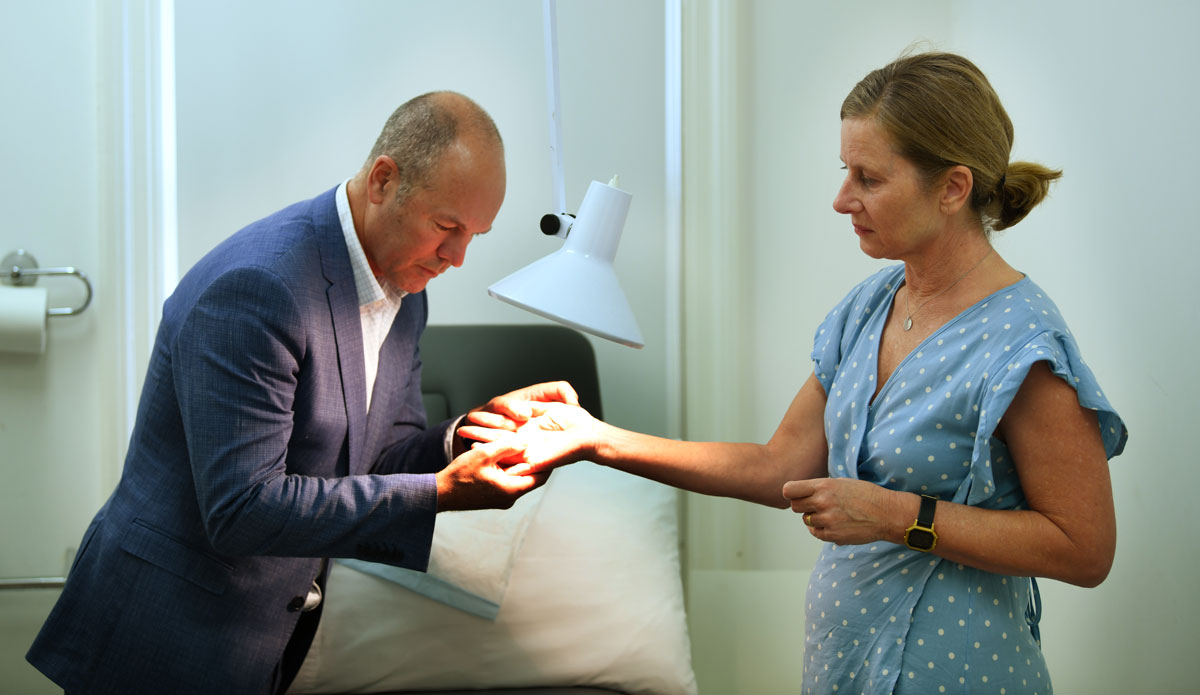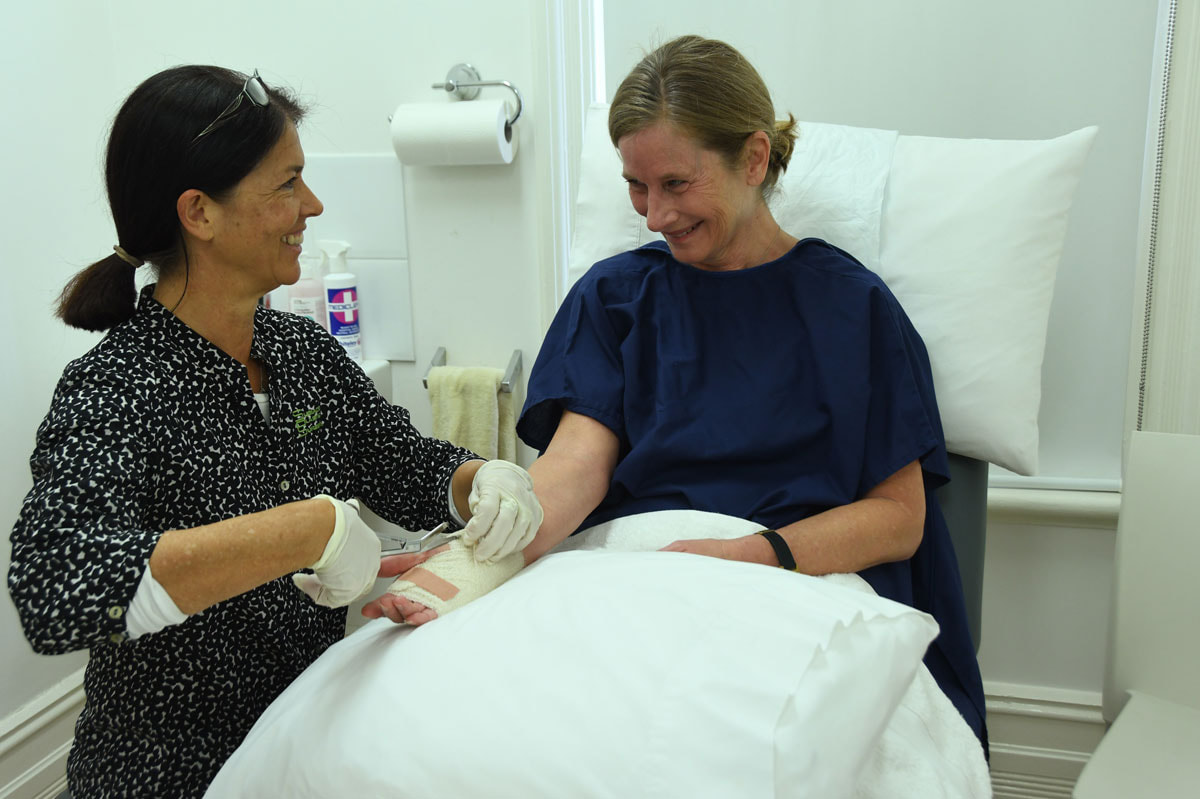Above image not a patient.
What is Dupuytren’s Disease Surgery?
Dupuytren’s Disease involves a thickening and contracture of the deeper layers of the tissue in the palm of the hand.
In its early form, it can cause pitting or nodules in the skin of the palm of the hand or along the fingers. In its more advanced stage, these areas can contract and cause the finger or fingers to become bent.
When surgery is performed, the diseased tissue is removed from beneath the skin and the joint contracture/contractures is corrected. The skin is carefully repaired, and a plaster is often placed on the hand for the first few days. Following this, several visits for dressings changes will be made and sessions attended with our expert hand therapists to restore movement and prevent stiffening of the fingers.
In its early form, it can cause pitting or nodules in the skin of the palm of the hand or along the fingers. In its more advanced stage, these areas can contract and cause the finger or fingers to become bent.
When surgery is performed, the diseased tissue is removed from beneath the skin and the joint contracture/contractures is corrected. The skin is carefully repaired, and a plaster is often placed on the hand for the first few days. Following this, several visits for dressings changes will be made and sessions attended with our expert hand therapists to restore movement and prevent stiffening of the fingers.
Commonly used terms – Viking disease, fingers bent.
Dupuytren’s Disease Surgeon Dr Lewis Blennerhassett
|
Dr Lewis Blennerhassett is a leading Perth Dupuytren’s Disease surgeon and has more than 25 years’ experience in this surgery.
He has trained extensively in hand surgery, including working closely with complex hand surgery expert Dr Joseph Upton, who is a clinical professor of surgery at Harvard Medical School and author of 250 articles and 60 book chapters on hand surgery. |
Dr Blennerhassett’s reconstructive skills from his additional plastic surgery training ensure that his hand surgery is focused on being meticulous and precise. Expert care is provided, prioritising safety and quality.
In recent years, he has surgically created new functional thumbs for more than 100 WA children born without thumbs.
Dupuytren’s Disease surgeon Dr Lewis Blennerhassett personally oversees your care from your first consultation through to full recovery. He is always happy to answer questions.
In recent years, he has surgically created new functional thumbs for more than 100 WA children born without thumbs.
Dupuytren’s Disease surgeon Dr Lewis Blennerhassett personally oversees your care from your first consultation through to full recovery. He is always happy to answer questions.
What causes Dupuytren’s Disease?
Although this condition is very common and has been described in the medical literature for many centuries, we are unfortunately still unsure as to why it occurs.
Older males are the commonest group to be affected, however the condition can certainly occur in females and younger people. Unfortunately, the younger patients tend to have a more significant disease and often require multiple operations.
Older males are the commonest group to be affected, however the condition can certainly occur in females and younger people. Unfortunately, the younger patients tend to have a more significant disease and often require multiple operations.
Who is at risk of Dupuytren’s Disease?
It is one of the most common hand conditions amongst the Australian population and affects almost 10% of Australian males in one form or another at some stage during their life.
Those most at risk of Dupuytren’s Disease are;
Those most at risk of Dupuytren’s Disease are;
- Males
- Those over 50-years-old.
- Those with a family history.
- Those of Northern European or Celtic descent (also known as Viking disease)
- Diabetics.
- Tobacco and alcohol users
Is Dupuytren’s Disease Surgery right for you?
In cases where the finger has become flexed to the point where it is becoming a problem from a functional point of view, then surgery is usually indicated.
A good way for a patient to assess whether the hand is ready for surgery is to attempt to place the hand flat on a table, palm side down. If it is not possible to get the hand flat, it is more likely that surgery will be recommended.
In early cases, where the hand can be placed flat, no treatment is recommended. There is no evidence that exercise or splints will alter the course of the disease.
A good way for a patient to assess whether the hand is ready for surgery is to attempt to place the hand flat on a table, palm side down. If it is not possible to get the hand flat, it is more likely that surgery will be recommended.
In early cases, where the hand can be placed flat, no treatment is recommended. There is no evidence that exercise or splints will alter the course of the disease.
Does Dupuytren’s Disease Surgery require anaesthesia?
Perth Dupuytren’s Disease surgeon Dr Lewis Blennerhassett usually performs this procedure under a short general anaesthetic (patient asleep). However, it is possible to be discharged from hospital the same day as the surgery.
His hand surgery is performed only in fully accredited, fully equipped hospitals. His anaesthetists are skilled and highly qualified.
His hand surgery is performed only in fully accredited, fully equipped hospitals. His anaesthetists are skilled and highly qualified.
What do I need to do before Dupuytren’s Disease Surgery?
No specific treatment is required before surgery, however it is important to tell Dr Blennerhassett if you are on any blood thinning medications.
What do I need to do after Dupuytren’s Disease Surgery?
|
You will have your hand in a plaster for approximately one week after the surgery.
Once the plaster is removed, you will be seen by our expert hand therapist for fitting of a splint and instructions on how to mobilise your fingers. You will continue to see the therapist periodically until your movement has returned to normal. Stitches are usually removed approximately 2 weeks after the surgery and during the first 4-6 weeks you will be gradually regaining your range of motion and use of the hand. |
Time off work or physical activities depends on the nature of the activities that are required, but most patients are back performing all of their normal activities within 4-6 weeks.
Dressings changes, carried out by our highly experienced nurses, will take place at Dr Blennerhassett’s Subiaco Plastic Surgery rooms until all healing is complete.
During the recovery period, Dr Blennerhassett will be contactable to answer your questions. His mobile number will be provided to you during pre-surgery consultations.
Dr Blennerhassett’s patients are given a website password to access our highly specialised aftercare advice on recovery and scar management. Patient information sheets can also be provided.
Dressings changes, carried out by our highly experienced nurses, will take place at Dr Blennerhassett’s Subiaco Plastic Surgery rooms until all healing is complete.
During the recovery period, Dr Blennerhassett will be contactable to answer your questions. His mobile number will be provided to you during pre-surgery consultations.
Dr Blennerhassett’s patients are given a website password to access our highly specialised aftercare advice on recovery and scar management. Patient information sheets can also be provided.
Dupuytren’s Disease Surgery words to know
Contracture – a shortening or distortion of muscular or connective tissue.
Sutures – stitches used to hold the skin and tissue together.
Sutures – stitches used to hold the skin and tissue together.
*Follow Dr Lewis Blennerhassett on Instagram - @perthhandsurgeon


